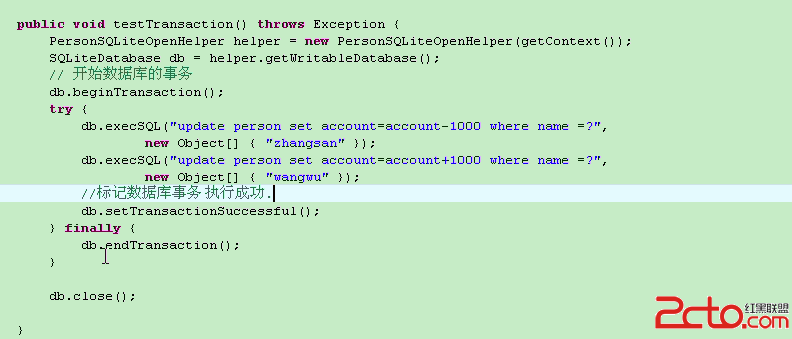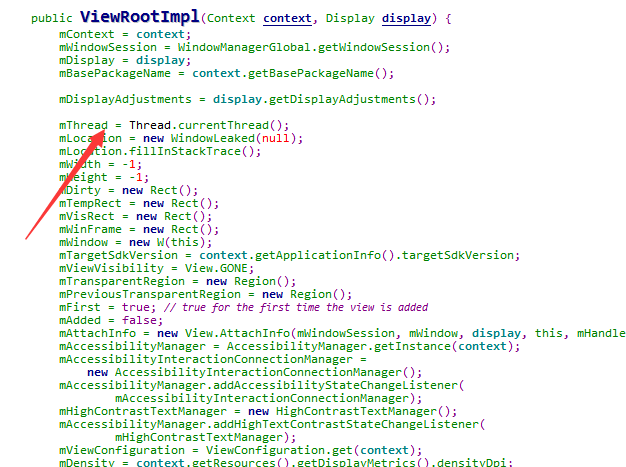編輯:關於Android編程
onCreate( )方法是android應用程序中最常見的方法之一,那麼,我們在使用onCreate()方法的時候應該注意哪些問題呢?
先看看Google Android Developers官網上的解釋:
onCreate(Bundle) is where you initialize your activity. Most importantly, here you will usually call setContentView(int) with a layout resource defining your UI, and using findViewById(int) to retrieve the widgets in that UI that you need to interact with programmatically.
Called when the activity is starting. This is where most initialization should go: calling setContentView(int) to inflate the activity‘s UI, using findViewById(int) to programmatically interact with widgets in the UI, calling managedQuery(android.net.Uri, String[], String, String[], String) to retrieve cursors for data being displayed, etc.
You can call finish() from within this function, in which case onDestroy() will be immediately called without any of the rest of the activity lifecycle (onStart(),onResume(), onPause(), etc) executing.
Derived classes must call through to the super class‘s implementation of this method. If they do not, an exception will be thrown.
翻譯過來就是說,onCreate()函數是在activity初始化的時候調用的,通常情況下,我們需要在onCreate()中調用setContentView(int)函數填充屏幕的UI,一般通過findViewById(int)返回xml中定義的視圖或組件的ID。子類在重寫onCreate()方法的時候必須調用父類的onCreate()方法,即super.onCreate(),否則會拋出異常。
但是,我們必須要注意的是,在onCreate()函數裡我們需要配置一些必要的信息,但是並不是所有的事情都能在這裡做。我們知道,一個activity啟動調用的第一個函數就是onCreate,它主要做這個activity啟動時一些必要的初始化工作,這個函數調用完後,這個activity並不是說就已經啟動了,或者是跳到前台了。而是還需要其他的大量工作,我們知道:onCreate之後還有onRestart()和onStart()等,實際上onStart()調用完畢了這個activity還沒有完全啟動,也只是前台可見,直到 onResume() 調用後這個onCreate才算終於啟動。既然這樣,那麼在一個activity真正啟動之前任何相當耗時的動作都會導致activity啟動緩慢,特別是在onCreate裡面耗時長的話可能導致極差的用戶體驗。
下面來看一個例子:
protected void onCreate(Bundle savedInstanceState) {
// TODO Auto-generated method stub
super.onCreate(savedInstanceState);
this.requestWindowFeature(Window.FEATURE_NO_TITLE);
mContext = this;
setContentView(R.layout.main);
dataLoad = new DataLoading();
mScrollLayout = (ScrollLayout)findViewById(R.id.ScrollLayoutTest);
btnExit = (ImageButton)findViewById(R.id.btn_exit);
btnExit.setOnClickListener(btnExitClickListener);
btnContacts = (ImageButton)findViewById(R.id.btn_contacts);
btnContacts.setOnClickListener(btnContactsClickListener);
mSpeedDailDataMgr = new SpeedDailMgr(this);
loadGripView();
//in MTK
//mCallOptionHandler = new CallOptionHandler(this);
mCallOptionHandler = new ContactsCallOptionHandler(this,
new ContactsCallOptionHandlerFactory());
//don't consider getting no data, ex: when starting up
updateEnabledCard();
}
這是一個APP的一個Activity的onCreate的寫法。其實這段代碼沒有什麼問題,而且看起來也是比較簡單的代碼。不過裡面大量危險的代碼段:不管是dataLoad = new DataLoading(); 還是 mSpeedDailDataMgr = new SpeedDailMgr(this);更或者是loadGripView();甚至updateEnabledCard();這麼危險的處理都是不應該在這裡來處理的。這裡包含了加載數據庫數據、讀取文件信息、讀取SIM卡信息,這些操作都是有可能拋出異常的,而且其操作耗時也是不確定的!對於面對這樣問題,我覺得應該注意下面幾個方面:
(1)在Activity啟動前,盡量少做。
(2)對於布局比較復雜的時候,可以考慮不要一次性全部加載上,動態加載是一個好的辦法。
(3)對於及時需要的數據,加載起來耗時的又有異常危險的,一定記得開辟一個線程來做這些動作,千萬記得不要做阻塞主線程(UI線程)的任何事情。
(4)對於特殊情況下,Activity啟動確實需要大量工作時候,可以考慮先加載一個簡單的布局(或是Activity)來過渡.。
(5)所有的目的都是讓你要啟動的組件盡快上場,而不是以畫好妝為主,這樣的話客人會等不及的,顧客就是上帝。
以上就是對Android OnCreate()方法的詳細介紹,後續繼續補充相關知識,謝謝大家對本站的支持!
 分答是什麼?分答怎麼玩?
分答是什麼?分答怎麼玩?
果殼網旗下在行在微信公眾號上線了一款付費語音問答新產品——分答。 用戶在分答上可以自我介紹或描述擅長的領域,設置付費問答
 ShareSDK集成
ShareSDK集成
第一步:下載SDK:1下載地址:http://www.mob.com/ 根據需求選擇需要的平台:第二步:申請ShareSDK的AppKey把鼠標移到頭像上,點擊進入後台:
 android 數據庫事務
android 數據庫事務
1、事務2、命令行操作數據庫
 android-如何在子線程中更新ui
android-如何在子線程中更新ui
正如我們知道的,android是不讓在子線程中更新ui的。在子線程中更新ui會直接拋出異常Only the original thread that created a